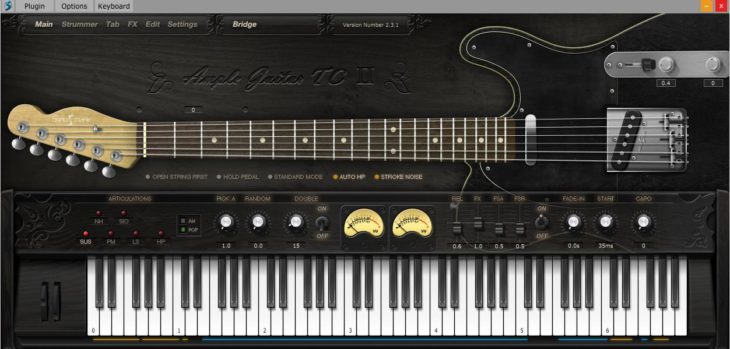AmpleSound’s new Ample Guitar TC II ($119) virtual instrument is a recreation of a custom built Fender Telecaster electric guitar in VST/AU/AAX/RTAS plugin formats.
The plugin is based on a modern day specimen of the first mass-produced solid body electric guitar.
The Sound
The sound is, in two words, very Telecaster. I’ve played a few “Teles” in my life, although not any high end Custom Shop ones, and this instrument sounds exactly as I’d expect. It’s bright and twangy with a percussive attack. Only the bridge pickup is sampled, which makes sense – nobody buys a Telecaster for the neck pickup. Maybe in the future a bridge and neck combo extension library would be nice for those times when you want something with the bridge pickup bite, but also some warmth underneath it. The samples do include an extensive array of noises, with various categories of release and fingering/shifting samples. The pick attack accentuation control works really well with this particular guitar, giving the sound extra percussive spank. All the samples together add up to 3.78 GB, which with 24-bit/44.1 kHz samples is enough to allow for good realism and detail.
The samples are generally very clean, with consistent attacks and no fret buzz even at the highest velocities. A guitar with a good neck and good frets, played by somebody who isn’t sloppy. Ample’s libraries in general have this “good session musician with good gear” feel.
The sound is obviously good for country, and also for anything else that requires a bright sound. It’s not surprising that the first demo on AmpleSound’s product page is a funk one. Indie rock and blues are also right up this guitar’s alley. It also responds well to distortion and with a palm muting articulation is surprisingly good for metal, as long as you don’t need very low tuning (though any string can be tuned down by a half step or full step, so you can get a low D). Unsurprisingly, it’s not very good for a warm and mellow typical jazz tone – but if it was, that would be seriously wrong.
The Engine
As I’ve already written in my earlier reviews of AmpleSound’s acoustic instruments this year, their entire lineup is very consistent in terms of functionality, and allows the sequencing of guitar parts in very guitarist-like ways. I’ve written about that (and also the built-in effects) in more detail on the previous reviews, so I will provide a quick summary here.
To make a long story short, this Telecaster can be used in many modes, from keyboard mode which allows multiple notes to be played on one string at the same time (not possible in reality, but very convenient sometimes) to splitting the instrument into six MIDI channels with each string controlled independently, or using the tab player to play parts sequenced in GuitarPro. There’s a new feature in the tab player, available in AGTC II and also in all other AmpleSound instruments upgraded to version 2.4, which allows the imported tab to be exported to MIDI, which means that you can tweak the part further in your DAW or conveniently copy-paste MIDI patterns.
I suspect most users will find the standard mode to be the most useful, though, with one MIDI channel for the whole instrument, each string playing one note at a time, and keyswitches used to control articulations. There are various controls in standard mode which you can either use or ignore, such as standard legato and position shifting. For realistic guitar parts that don’t take hours of sequencing, this is a happy medium.
There’s also a strumming engine which can be used in several ways. The chords can either be detected or selected using keyswitches, and the strums themselves can either be sequenced one strum at a time or selected from hundreds of patterns in styles from country to metal. Being able to control how much the strings are allowed to ring is especially useful on an electric, as the sound can go from sustained indie jangle to tight percussive funk. All that might seem like a strum engine which has it all, but cycling through some of the patterns I think it actually lacks some very boring basic patterns which would be really useful for quickly laying down background parts in tracks where something else is at the forefront. The strumming engine is obviously good when my biggest complaint is that it needs more boring content.
The engine does a good job of keeping CPU usage low, and an excellent job of keeping RAM usage low – a benefit of developing your own guitar-specific engine which loads the most used samples into RAM, and streams the rest from the hard drive.
Summary
A very Telecaster virtual instrument, AGTC II nails the archetypal Tele sound. It won’t be the only virtual electric guitar you’ll ever need, but it’s great for taking care of the bright and percussive side of electric guitar sounds.



1 Comment
Kamthoy Mungray
onThank you